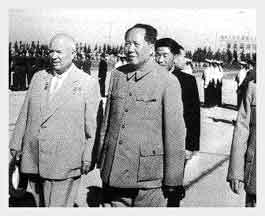1960 Sino-Soviet Split
An ideological split developed between the Communist Chinese and the communist government of the Soviet Union. The ideological routes of the dispute lay in the more pragramatic approach to world affairs that Premier Khrushchev was taking. In addition the long simmering border disputes between the parties began to effect their relations.
The ideological split between the Communist Chinese and the Soviet Union, known as the Sino-Soviet split, was a significant event in the history of the Cold War and the global communist movement. The split emerged in the late 1950s and early 1960s, leading to a deterioration of relations between the two countries.
The roots of the ideological dispute between China and the Soviet Union can be traced back to differences in their approaches to communist ideology and world affairs. At the time, the Soviet Union, under the leadership of Premier Nikita Khrushchev, was pursuing a more pragmatic approach to governance and international relations. Khrushchev introduced a policy of "de-Stalinization," denouncing some of the excesses and policies of his predecessor, Joseph Stalin.
This pragmatic approach by Khrushchev included a willingness to seek peaceful coexistence and engage in diplomatic negotiations with the capitalist West. It represented a departure from the more revolutionary and confrontational stance of Stalin. The Soviet Union aimed to establish better relations with the United States and pursue a policy of peaceful competition known as "peaceful coexistence."
On the other hand, the Chinese Communist Party, led by Chairman Mao Zedong, viewed Khrushchev's approach as revisionist and deviating from the true principles of Marxism-Leninism. Mao and his supporters believed in a more radical and revolutionary interpretation of communism, emphasizing class struggle and permanent revolution.
The ideological differences between the Chinese and the Soviets were amplified by the simmering border disputes between the two countries. The Soviet Union and China shared a border, and tensions arose over territorial claims and conflicting interests. The border clashes, particularly in 1969, further strained their relationship and contributed to the ideological split.
As the split deepened, both sides engaged in ideological polemics, criticizing each other's policies and questioning their commitment to the principles of communism. The Chinese accused the Soviet Union of betraying the revolutionary cause and becoming a revisionist state, while the Soviets criticized the Chinese for pursuing an overly aggressive and adventurist foreign policy.
The Sino-Soviet split had significant geopolitical implications. It divided the international communist movement and weakened the unity of the socialist bloc. It also affected global politics during the Cold War as the Soviet Union and China competed for influence in different parts of the world.
The split lasted for several decades, with occasional periods of tension and reconciliation. It wasn't until the 1980s, with the rise of reformist leader Mikhail Gorbachev in the Soviet Union and Deng Xiaoping in China, that relations between the two countries began to thaw. However, the ideological divide and mistrust continued to shape their interactions even after the formal end of the split.
 >
>